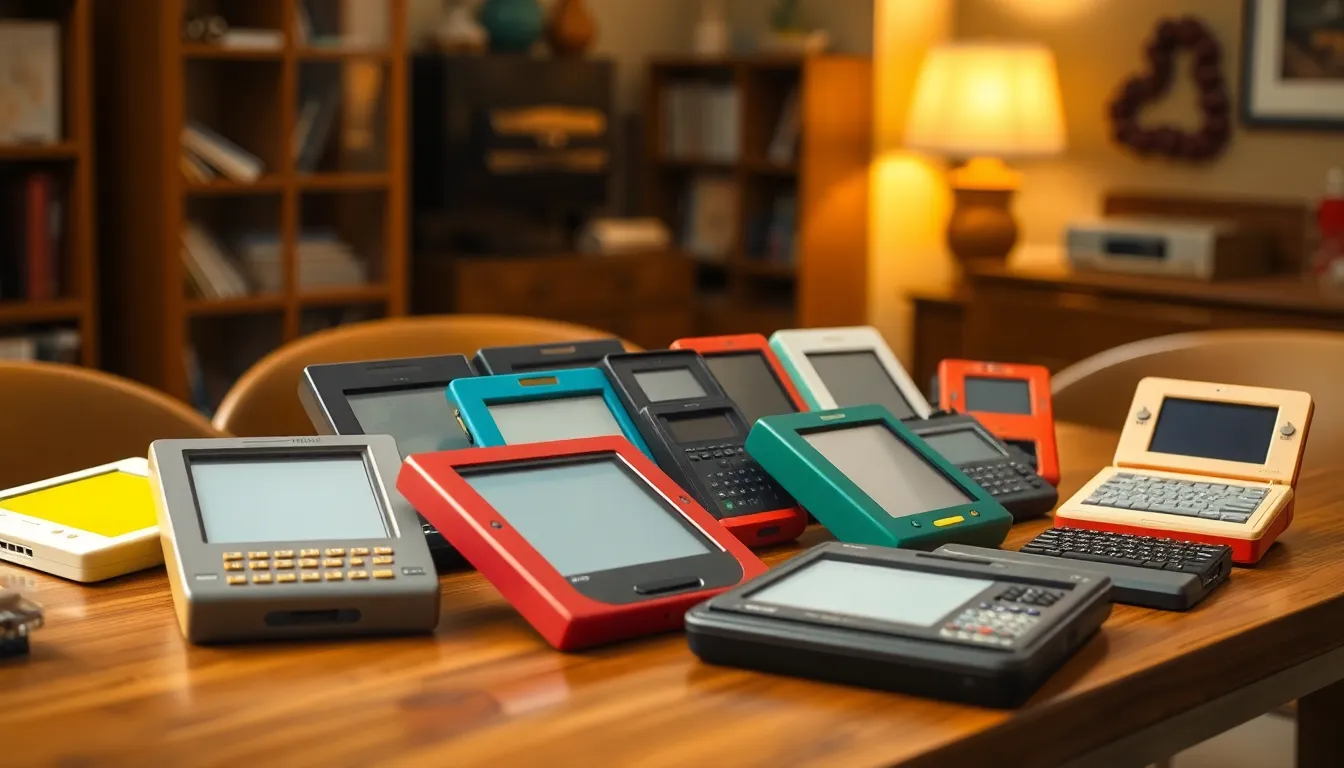Table of Contents
ToggleIn a world obsessed with the latest tech gadgets, vintage tablets might just be the quirky underdogs we didn’t know we needed. Imagine a time when tablets didn’t come with a million apps or require a PhD to operate. These retro devices offer a delightful glimpse into the past, where simplicity reigned and every swipe felt like an adventure.
Overview Of Vintage Tablets
Vintage tablets stand out for their unique features and historical significance. Collectors find value in their design, functionality, and the nostalgia they evoke. These devices often showcase simple interfaces, which contrast sharply with modern technology.
Tablets from the early 1990s, such as the Apple Newton and the Fujitsu Stylistic series, reflect technological experimentation of that era. Many of these models were groundbreaking for their time, paving the way for today’s touch-screen devices. Features like handwriting recognition, albeit imperfect, captivated users and highlighted the innovative spirit of the time.
Significant advancements appeared in the late 1990s and early 2000s, particularly with devices like the Palm Pilot and the Microsoft Tablet PC. Functionality allowed for tasks such as note-taking, scheduling, and basic web browsing. Enthusiasts appreciate how these tablets symbolize the early adoption of mobile computing.
Preservation of vintage tablets ensures their legacy endures. Many individuals engage in restoration projects to bring old devices back to life, fostering a community dedicated to their appreciation. Various online platforms and forums connect vintage tablet enthusiasts, offering a space to share knowledge, resources, and restoration tips.
Collectors frequently search for specific vintage models, driven by personal affinity or technological curiosity. Auctions, online marketplaces, and specialty shops offer opportunities to find rare tablets. Prices can vary significantly based on age, condition, and rarity, creating an intriguing market dynamic.
Examining the charm of vintage tablets reveals more than just nostalgia; they represent an important chapter in technological evolution. Each device carries stories of innovation, creativity, and the ever-changing landscape of personal technology.
Key Features Of Vintage Tablets

Vintage tablets showcase distinct characteristics that set them apart from modern devices. These features appeal to collectors and enthusiasts alike.
Design And Aesthetics
Unique designs define vintage tablets, often reflecting the era they originate from. Colorful cases and distinct shapes make them eye-catching pieces. Retro interfaces, such as stylus inputs and physical buttons, contribute to their charm. Many early models prioritized portability, resulting in compact sizes that fit comfortably in one hand. Iconic designs like the Apple Newton boast curvy edges, while others, like the Fujitsu Stylistic, favor a more utilitarian look. Attention to detail emphasizes craftsmanship, making these devices desirable collectibles.
Functionality And Usability
Limited features characterize vintage tablets, providing a straightforward user experience. Basic functions include note-taking, address book management, and simple web browsing. Early operating systems often focused on handwriting recognition and calendar applications. User interfaces maintained simplicity, accommodating users unfamiliar with advanced technology. Battery life typically ranged from 4 to 10 hours, allowing for adequate usage without frequent recharging. While modern tablets offer extensive functionalities, vintage models prioritize particular uses, which can enhance user satisfaction. Collectors appreciate the usability that complements the nostalgic design.
Popular Vintage Tablet Models
Vintage tablets hold significant appeal for collectors and tech enthusiasts alike. Not only do they evoke nostalgia, but they also encapsulate technological milestones from their respective eras.
Model 1: The Apple iPad (First Generation)
The first generation of the Apple iPad debuted in 2010, marking a revolutionary step in tablet computing. This model featured a 9.7-inch display, a sleek aluminum chassis, and a user-friendly interface. It provided access to the App Store, allowing users to download applications and games. This initial iPad supported up to 64 GB of storage, accommodating various media and applications. Its success established the iPad as a benchmark for modern tablets. Collecting this model appeals due to its pivotal role in popularizing tablet technology. Many enthusiasts cherish it for its design simplicity and functionality, making it a sought-after piece in vintage tech collections.
Model 2: The Samsung Galaxy Tab (First Generation)
Launched in 2010, the Samsung Galaxy Tab (First Generation) offered an alternative to Apple’s iPad. Featuring a 7-inch touchscreen display, it emphasized portability and ease of use. This tablet supported both Wi-Fi and 3G, allowing users to stay connected on the go. Its Android operating system provided a different set of applications compared to its Apple counterpart. Moreover, it incorporated expandable storage through microSD cards, a unique feature appreciated by many users. Collectors value this model for its innovative approach to mobile computing. Its distinctive design and contributions to the evolving tablet market make the Samsung Galaxy Tab (First Generation) a notable collectible.
Collecting Vintage Tablets
Collectors increasingly appreciate vintage tablets for their unique designs and historical significance. These devices bring a sense of nostalgia, making them appealing to those who value technology’s evolution. The charm lies in their straightforward functionality, often limited to essential tasks like note-taking and basic web browsing. Age, condition, and rarity primarily influence market dynamics for these collectibles.
Among the popular models, the Apple Newton stands out for its innovative features in the 1990s. This early tablet introduced handwriting recognition, capturing the imagination of tech enthusiasts. The Fujitsu Stylistic series offers another example; its distinctive form factor and varied applications showcased the potential of mobile computing during its time.
The Palm Pilot gained fame in the late 1990s due to its portability and practicality. Enthusiasts treasure this device for its role in shaping personal digital assistants. Microsoft Tablet PCs also contributed to this era, providing a bridge between laptops and portable devices. Collectors often seek these models for their contributions to the tech landscape.
Community dynamics play an essential role in collecting vintage tablets. Enthusiasts often share restoration tips, trade devices, and exchange knowledge about the best preservation techniques. Online forums and social media groups foster connections, uniting people with a shared passion for retro tech.
Collectors frequently focus on unique features that tell a story. Colorful cases, distinct shapes, and craftsmanship highlight the era’s style. This emphasis on design connects collectors to the past, making vintage tablets not just functional items but cherished artifacts.
Maintaining And Restoring Vintage Tablets
Maintaining and restoring vintage tablets requires careful attention and specialized knowledge. Regular cleaning helps preserve their aesthetic appeal; use a soft, lint-free cloth to avoid scratches on screens. Examining battery conditions becomes crucial; many vintage devices utilize NiCad or NiMH batteries which may have degraded over time and require replacement.
Collecting spare parts from reputable sources enhances restoration efforts, as certain models may no longer be in production. Ensuring that replacement components match original specifications supports functionality. Evaluating software compatibility is also important; utilizing emulators can extend the usability of older systems, allowing for a wider range of applications.
Community support proves invaluable for enthusiasts; online forums and social media groups facilitate knowledge sharing, including restoration techniques and tips. Documenting the restoration process can create a fascinating narrative for collectors, adding depth to the device’s history.
Special care for unique features enhances user experience; for instance, early models often rely on specific applications or stylus interactions. Knowledge of these intricacies makes maintaining device functionality easier. Certain vintage tablets, like the Apple Newton and Fujitsu Stylistic, often have service manuals available online, enabling insightful repair methods.
Understanding the age and rarity of each tablet contributes to a successful restoration; vintage models may demand different techniques. Collecting valuable resources such as original documentation or user manuals often proves beneficial. Engaging in this meticulous process enriches the connection between collectors and their devices, preserving nostalgia for future generations.
Vintage tablets embody a unique blend of nostalgia and innovation that continues to captivate collectors and tech enthusiasts alike. Their straightforward functionality and distinctive designs offer a refreshing contrast to today’s complex devices. As these retro gadgets gain popularity, the community surrounding them thrives, fostering a shared appreciation for their historical significance.
The meticulous restoration and preservation of these tablets not only keep their legacy alive but also strengthen the bond between collectors and their treasured artifacts. Each device tells a story of technological evolution, reminding us of the creativity and experimentation that paved the way for modern computing. Embracing vintage tablets allows individuals to connect with the past while celebrating the journey of technology.




